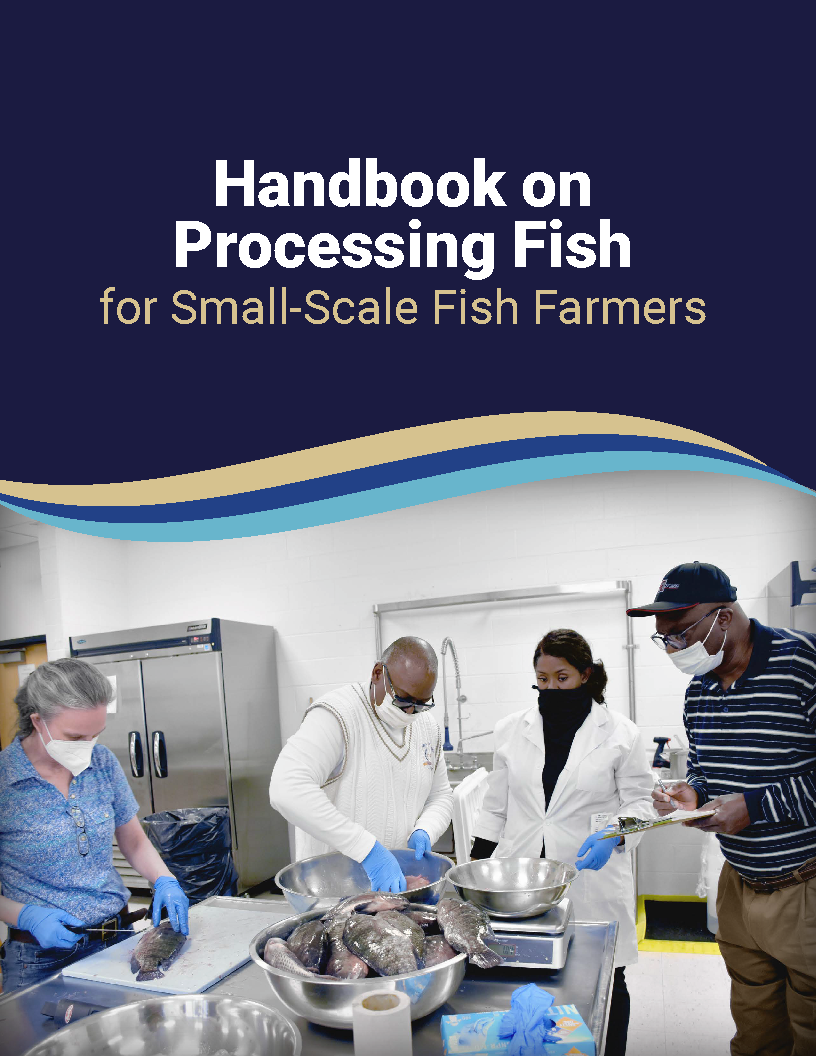Results
File Type: pdf
File Size: 2.63 MB
Year: 2023
The handbook highlights the necessary elements of processing fish to guide any interested fish farmer or entrepreneur.
Download File
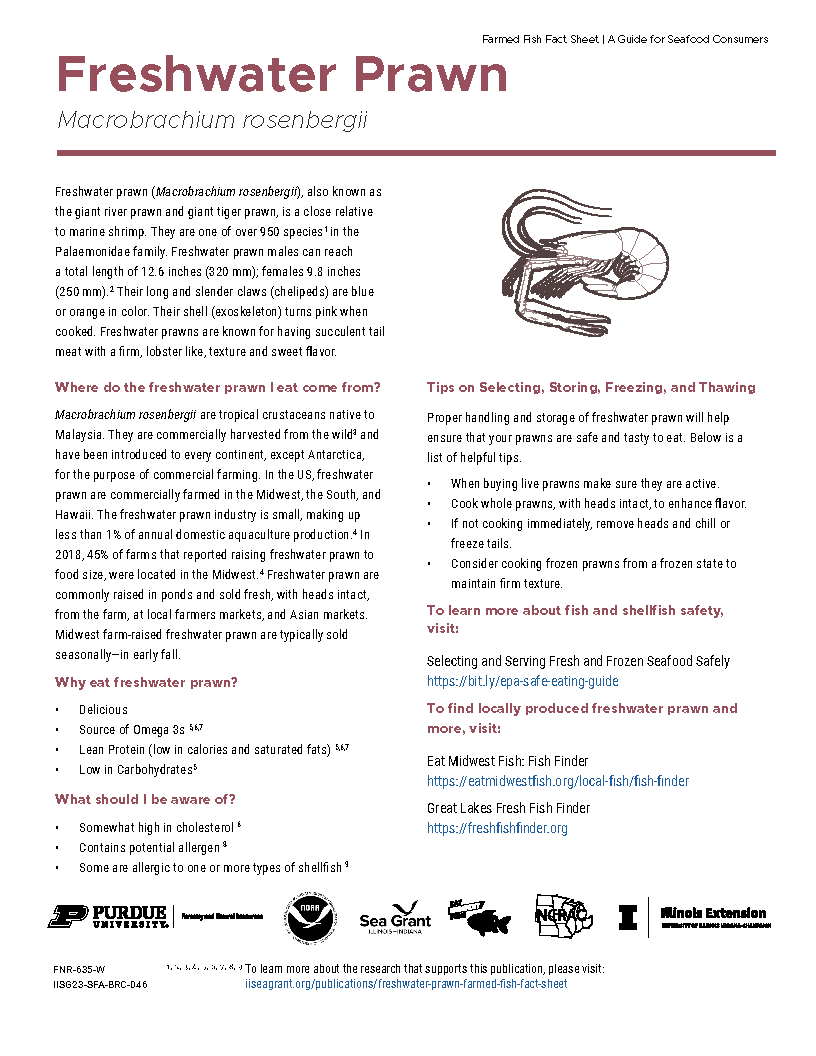
File Type: pdf
File Size: 4.45 MB
Year: 2023
This is the tenth in a series of consumer guides that describe fish and shellfish farmed in the Midwest region of the United States. (See Largemouth Bass Farmed Fish Fact Sheet, Atlantic Salmon Farmed Fish Fact Sheet, Walleye Farmed Fish Fact Sheet, Yellow Perch Farmed Fish Fact Sheet, Tilapia Farmed Fish Fact Sheet, Rainbow Trout Farmed Fished Fact Sheet, Pacific White Shrimp Farmed Fish Fact Sheet, American Paddlefish Farmed Fish Fact Sheet, and Channel Catfish Farmed Fish Fact Sheet). The fact sheet also includes culinary characteristics, cooking tips and a recipe for Grilled Prawn with Thai Dipping Sauce.
References:
- Molina WF, Costa GWWF, Cunha IMC, Bertollo LAC, Ezaz T, Liehr T, Cioffi MB. Molecular Cytogenetic Analysis in Freshwater Prawns of the Genus Macrobrachium (Crustacea: Decapoda: Palaemonidae). Int J Mol Sci. 2020 Apr 9;21(7):2599. doi: 10.3390/ijms21072599. PMID: 32283616; PMCID: PMC7178241.
- FAO 2022. Macrobrachium rosenbergii. Cultured Aquatic Species Information Programme. Text by New, M. B.. Fisheries and Aquaculture Division [online]. Rome. [Cited Monday, December 19th 2022]. Available online: https://www.fao.org/fishery/en/culturedspecies/macrobrachium_rosenbergii/en
- FAO. 2021. FAO Yearbook. Fishery and Aquaculture Statistics 2019/FAO annuaire. Statistiques des pêches et de l’aquaculture 2019/FAO anuario. Estadísticas de pesca y acuicultura 2019. Rome/Roma. Available online: https://doi.org/10.4060/cb7874t.
- United States Department of Agriculture Census of Agriculture: 2018 Census of Aquaculture. 2018. United States Department of Agriculture National Agricultural Statistics Service. Available online: https://www.nass.usda.gov/Publications/AgCensus/2017/Online_Resources/Aquaculture/index.php.
- DV Prasuna Devi, K Hareesh, M Srinivasulu Reddy. “Study on the Proximate Composition of Tropical Freshwater Prawn Macrobrachium rosenbergii.” International Journal of Fisheries and Aquatic Studies, 3(1) (2015): 329-336. Available online: https://www.fisheriesjournal.com/vol3issue1/Pdf/3-1-64.1.pdf.
- Yadzir ZH, Misnan R, Abdullah N, Bakhtiar F, Arip M, Murad S. Identification of the major allergen of Macrobrachium rosenbergii (giant freshwater prawn). Asian Pac J Trop Biomed. 2012 Jan;2(1):50-4. doi: 10.1016/S2221-1691(11)60189-5. PMID: 23569834; PMCID: PMC3609200.
- Shellfish allergy. Mayo Clinic. Available online: https://www.mayoclinic.org/diseases-conditions/shellfish-allergy/symptoms-causes/syc-20377503
- Rangappa, T. Raj Kumar, P. Jaganmohan and M. Srinivasulu Reddy. “Studies on the Proximal Composition of Freshwater Prawns Macrobrachium rosenbergii and Macrobrachium malcomsonii.” World Journal of Fish and Marine Sciences, 4 (2) (2012):218-222. Available online: https://www.idosi.org/wjfms/wjfms4(2)12/18.pdf.
- Bragagnolo and D. B. Rodriguez-Amaya. “Total Lipid, Cholesterol, and Fatty Acids of Farmed Freshwater Prawn (Macrobrachium rosenbergii) and Wild Marine Shrimp (Penaeus brasiliensis, Penaeus schimitti, Xiphopenaeus kroyeri).” Journal of Food Composition and Analysis, 14 (2002): 359-369. Available online: http://www.idealibrary.com.
Download File
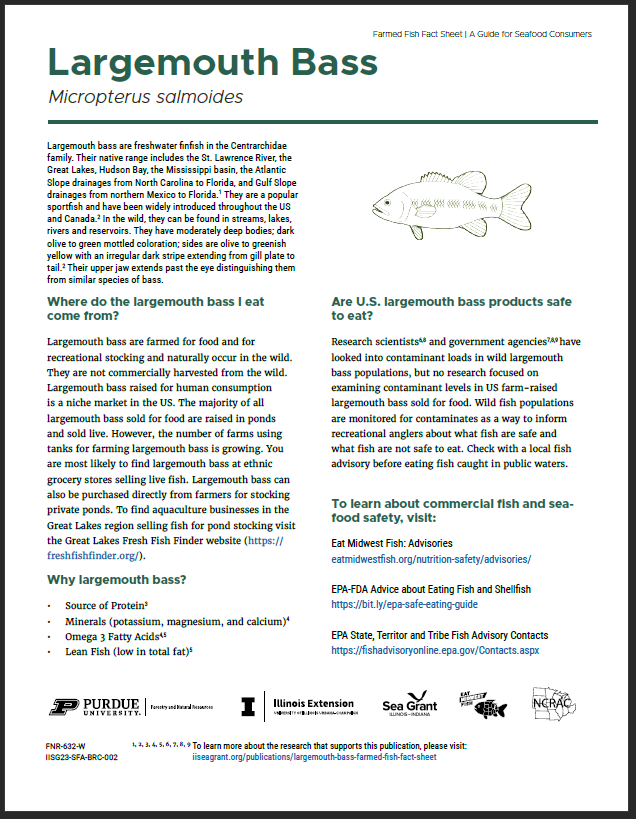
File Type: pdf
File Size: 3.61 MB
Year: 2023
This is the ninth in a series of consumer guides that describe fish and shellfish farmed in the Midwest region of the United States. (See Atlantic Salmon Farmed Fish Fact Sheet, Walleye Farmed Fish Fact Sheet, Yellow Perch Farmed Fish Fact Sheet, Tilapia Farmed Fish Fact Sheet, Rainbow Trout Farmed Fished Fact Sheet, Pacific White Shrimp Farmed Fish Fact Sheet, American Paddlefish Farmed Fish Fact Sheet, and Channel Catfish Farmed Fish Fact Sheet). The fact sheet also includes culinary characteristics, cooking tips and a recipe for Pan Fried Largemouth Bass with Garlic Herb Sauce.
References:
- Fuller, P., Neilson, M., and Procopio, J., 2022, Micropterus salmoides (Lacepède, 1802): U.S. Geological Survey, Nonindigenous Aquatic Species Database, Gainesville, FL. Available online: https://nas.er.usgs.gov/queries/factsheet.aspx?SpeciesID=401#:~:text=Native%20Range%3A%20Largemouth%20Bass%20are,and%20south%20to%20the%20Gulf
- National Audubon Society. 2002. National Audubon Society Field Guide to Fishes. Chanticleer
Press, Inc.
- Portz, L. and Cyrino, J.E.P. (2003), Comparison of the amino acid contents of roe, whole body and muscle tissue and their A/E ratios for largemouth bass Micropterus salmoides (Lacepéde, 1802). Aquaculture Research, 34: 585-592. Available online: https://doi.org/10.1046/j.1365-2109.2003.00834.x
- Zou, J., Zhong, L., Song, C., Hu, G., Qiu, L., & Chen, J. (2022). Effects of different diets on fatty acid composition and nutritional values of largemouth bass (Micropterus salmoides). Aquaculture Research, 53, 2287– 2297. Available online: https://doi.org/10.1111/are.15747
- Branciari R, Franceschini R, Roila R, Valiani A, Pecorelli I, Piersanti A, Haouet N, Framboas M, Ranucci D. Nutritional Value and Contaminant Risk Assessment of Some Commercially Important Fishes and Crawfish of Lake Trasimeno, Italy. International Journal of Environmental Research and Public Health. 2020; 17(7):2545. Available online: https://doi.org/10.3390/ijerph17072545
- Karouna-Renier, N., Snyder, R. A., Lange, T., Gibson, S., Allison, J., Wagner. M., Ranga, R. k.. 2011. “Largemouth Bass (Micropterus Salmoides) and Striped Mullet (Mugil Cephalus) as Vectors of Contaminants to Human Consumers in Northwest Florida.” Marine environmental research 72.3 (2011): 96–104.
- United States Environmental Protection Agency. (2001). Charles River Fish Contaminate Survey. Available online: https://www.epa.gov/sites/default/files/2015-10/documents/charles-fish-contaminant-survey.pdf
- “Accumulation of Pollutants in Fish and Shellfish from the Northwest Florida Region
Final Report: Center for Environmental Diagnostics and Bioremediation and Research Ecologist USGS Patuxent Wildlife Research Center. (2009). Accumulation of Pollutants in Fish and Shellfish from the Northwest Florida Region Final Report. Available online: https://pages.uwf.edu/cedb/PERCH_Accumulation_of_pollutants_in_fish_and_shellfish.pdf
- Department of State Health Services, Division for Regulatory Services, Policy, Standards and Quality Assurance Unit, Seafood and Aquatic Life Group. (2015). Characterization of potential Adverse Health Effects Associated with Consuming Fish from Fosdic Lake, Tarrant County, Texas.
Download File
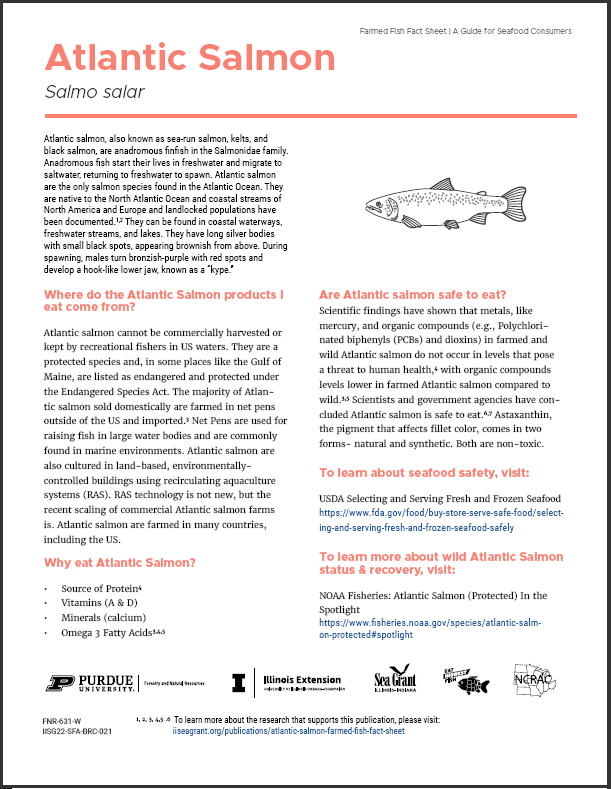
File Type: pdf
File Size: 1.18 MB
Year: 2022
This is the eighth in a series of consumer guides that describe fish and shellfish farmed in the Midwest region of the United States. (See Walleye Farmed Fish Fact Sheet, Yellow Perch Farmed Fish Fact Sheet, Tilapia Farmed Fish Fact Sheet, Rainbow Trout Farmed Fished Fact Sheet, Pacific White Shrimp Farmed Fish Fact Sheet, American Paddlefish Farmed Fish Fact Sheet, and Channel Catfish Farmed Fish Fact Sheet). The fact sheet also includes culinary characteristics, cooking tips and a recipe for Easy Baked Salmon.
References:
- National Audubon Society. 2002. National Audubon Society Field Guide to Fishes. Chanticleer Press, Inc.
- Fish Watch. U.S. Seafood Facts. Available online: https://www.fishwatch.gov/profiles/atlantic-salmon?_ga=2.87721752.1801739739.1658525024-826017170.1655993192.
- Jensen IJ, Eilertsen KE, Otnæs CHA, Mæhre HK, Elvevoll EO. 2020. “An Update on the Content of Fatty Acids, Dioxins, PCBs and Heavy Metals in Farmed, Escaped and Wild Atlantic Salmon (Salmo salar L.) in Norway.” Foods,19;9(12):1901. Available online: https://www.mdpi.com/2304-8158/9/12/1901.
- Foran, J, Hites, R, Carpneter, D, Hamilton, C, Mathew-Amos, A, and Schwager, S. 2004. “A Survey of Metals in Tissue of Farmed Atlantic and Wild Pacific Salmon.” Environmental Toxicology and Chemistry, Vol 23 (9), pp. 2108–2110.
- Lundebye, A, Lock, E, Rasinger, J, Nøstbakken, O, Hannisdal, R, Karlsbakk, E, Wennevik, V, Madhun, A, Madsen, L, Eide Graff, I, Ørnsrud, R. 2017. “Lower levels of Persistent Organic Pollutants, metals and the marine omega 3-fatty acid DHA in farmed compared to wild Atlantic salmon (Salmo salar).” Environmental Research, Vol 155: 49-59. Available online: https://doi.org/10.1016/j.envres.2017.01.026.
- EPA-FDA Advice about Eating Fish and Shellfish: For Those Who Might Become Pregnant, Are Pregnant, Are Breastfeeding, and for Children. Available online: https://www.epa.gov/fish-tech/epa-fda-advice-about-eating-fish-and-shellfish.
- Fish for Your Health Wallet Card. 2020. Available online: https://www.purdue.edu/hhs/nutr/fish4health/Walletcard/walletCard.html.
Download File
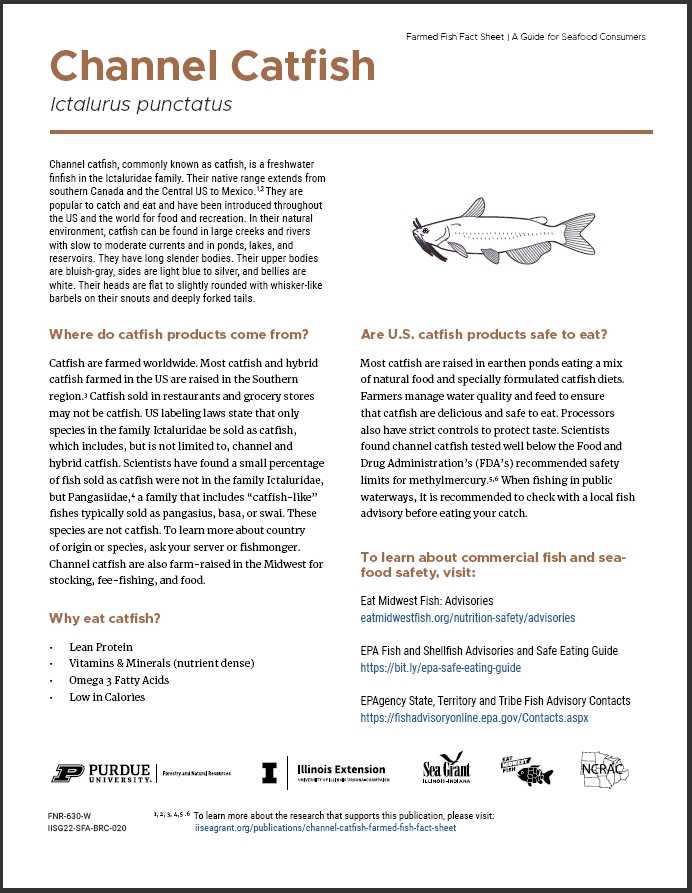
File Type: pdf
File Size: 4.79 MB
Year: 2022
This is the seventh in a series of consumer guides that describe fish and shellfish farmed in the Midwest region of the United States. (See Walleye Farmed Fish Fact Sheet, Yellow Perch Farmed Fish Fact Sheet, Tilapia Farmed Fish Fact Sheet, Rainbow Trout Farmed Fished Fact Sheet, Pacific White Shrimp Farmed Fish Fact Sheet, and American Paddlefish Farmed Fish Fact Sheet). The fact sheet also includes culinary characteristics, cooking tips and a recipe for Classic Fried Catfish.
References:
- Pam Fuller, and Matt Neilson, 2022, Ictalurus punctatus (Rafinesque, 1818): U.S. Geological Survey, Nonindigenous Aquatic Species Database, Gainesville, FL, https://nas.er.usgs.gov/queries/factsheet.aspx?SpeciesID=2341, Revision Date: 10/4/2019, Peer Review Date: 5/29/2012, Access Date: 6/27/2022
- National Audubon Society. 2002. National Audubon Society Field Guide to Fishes. Chanticleer
Press, Inc.
- United States Department of Agriculture Census of Agriculture: 2018 Census of Aquaculture. 2018. United States Department of Agriculture National Agricultural Statistics Service. Available online: https://www.nass.usda.gov/Publications/AgCensus/2017/Online_Resources/Aquaculture/index.php
- Bosko, Shayna A., Denise M. Foley, and Rosalee S. Hellberg. “Species substitution and country of origin mislabeling of catfish products on the US commercial market.” Aquaculture 495 (2018): 715–720.
- Santerre, C.R. & Bush, P.B. & Xu, De-Hai & Lewis, G.W. & Davis, J.T. & Grodner, R.M. & Ingram, R. & Wei, C.I. & Hinshaw, Jeffrey. “Metal Residues in Farm‐Raised Channel Catfish, Rainbow Trout, and Red Swamp Crayfish from the Southern U.S.” Journal of Food Science 66 (2001): 270–273. DOI: 10.1111/j.1365-2621.2001.tb11330.x.
- Fish for Your Health Wallet Card. 2020. Available online: https://www.purdue.edu/hhs/nutr/fish4health/Walletcard/walletCard.html
Download File
File Type: pdf
File Size: 12.20 MB
Year: 2022
Illinois-Indiana Sea Grant’s annual magazine.
Download File
Page 2 of 7
Note: Some older Illinois-Indiana Sea Grant publications have not yet been restructured into ADA compliant formats. We are actively working on this. If you are having difficulty accessing a particular item in one of our databases, please contact iisg@purdue.edu with the name of the item and its URL for further assistance.
